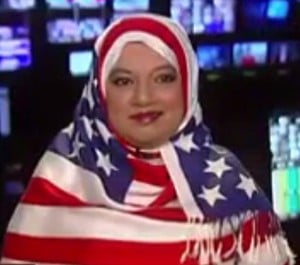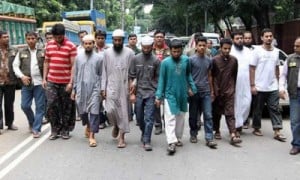This was written by Farah Banihali and originally published at Nuseiba.
Last month a forum was held at the Adelaide Festival of Ideas focusing on Islam and feminism. Called “Beyond the Veil: Islam and Feminism”, it involved Dr. Gary Bouma, a sociology academic at Monash University; Zainah Anwar, founder of Malaysian group Sisters in Islam (SIS) and a founding director of Musawah; and Dr. Shakira Hussein, an academic at ANU.
So with big expectations about the forum and the issues that would (potentially) be discussed, the title irritates me. Articles with the title “beyond/under/underneath/uncovering/taking off/doing something to the hijab/veil/burka” and other similar metaphors fixate on items of clothing and taking them off. The moderator mentioned that the word “beyond” was chosen because they wanted a discussion on Islam and feminism which included the hijab in the discussion but wasn’t fixated on it. It’s a valid sentiment, but it could have been done without the reference to it.
The forum goes over one hour long and some interesting points were made (you can download the podcast here). In this post, I wanted to focus on a few points made in the debate. The most interesting aspect was hearing Zainah Anwar speak. The development of gender politics in South East Asia is a really interesting area and I’ve done some research focusing on the work Sisters in Islam do in Malaysia.
Throughout the forum, Anwar highlights the challenge she believes Muslim feminists pose by questioning the authority of male-dominated institutions – “who decides this is the verse that determines the relationship between men and women? Who decides which interpretation will be favoured over the other?”
The question of “authority” is a significant one. Women’s groups are operating within a traditionally male-dominated environment. Law and social reform by these groups is met with a constant stream of arguments against their struggle in order to silence these dissenting voices within society. The recent experience of SIS highlights this point. They spoke out against the caning of Kartika Sari Dewi Shukarno, but have been accused of being agents for foreign anti-Islamic groups.
On this issue, I’d add to Anwar that (it’s clichéd, but true) history is written by people with authority – people who shape our understanding of past events. For Islam, this means that a rich history of women’s leadership and empowerment is denied to women. Like Anwar states, these are tactics used by men to maintain the status quo: to silence and delegitimize dissenting voices in society.
Early in the forum, Hussein mentions an important point on discussions of Islam. Women are included in the discussion, but are routinely sidelined to discuss only the hijab, whereas men are given the space and power to discuss everything else which affects Muslims. Krista at MMW made a similar point when reviewing a forum organised by ISNA.
Another point which Hussein highlights is the obsession with the hijab. The hijab continues to be the focal point of the discussion on Islam and women’s rights especially among non-Muslims (Chesler v Wolf, anyone?) While discussion on Islamic feminism should go further than the hijab, Muslim women respond to those writers because our voices should be included within the debate. But the same issues get repeated again and again and it’s difficult to try and move beyond that discussion because so much of the focus is on the hijab. It’s something I’ve encountered here at Nuseiba – I’ve written a lot of non-hijab posts but there’s an equal amount of posts focussing on the hijab. I think I’ve discussed the hijab more on this blog than anywhere else, which is a little odd for me sometimes because I don’t have that much experience with it. In the end, the constant focus on the hijab obscures the real issue: challenging the structures which perpetuate the disempowerment of women.
Another point which was mentioned in the forum and is often overlooked is the diversity among Muslim woman’s dress. For the majority of Muslim women, the distinction isn’t as simple as being veiled/unveiled. Hussein discusses her experiences in Pakistan, and they’re quite similar to mine with the Kashmiris I know. I mentioned above that I don’t have much experience with the hijab and I don’t – in my family and wider community there’s only three women who wear the hijab. However, while women don’t wear the hijab, they do veil when the situation requires them to. Most of the women, including my mother, wear shalwar kameez and cover their hair with their dupattas when they need to. Veiling and unveiling is more a continuum of experience rather than a strict dichotomy. There are women who wear hijab and women who don’t, there are some women who fall in between those two positions, some women used to wear the hijab but decided to stop, some don’t wear the hijab but want to, some who don’t at all but wear modest clothes otherwise and not all women who wear hijab do so in the same way. These sound like simple enough points to be making, but it’s a diversity which is often overlooked in debates on women’s dress in Islam. In the end, there are no easy cookie-cutter categories to slot in Muslim women. The hijab represents just one aspect of that diversity.
One of the questions asked by the audience at the end of the forum was whether western feminists have a place commenting on Muslim women. It’s an issue that’s come up time and time again, on this blog and elsewhere. Both Anwar and Hussein stressed that in regards to gender politics within Islam, Muslim women must lead the way to change. Feminists decrying the Taliban were criticized for taking up that struggle ahead of the women they were ‘liberating’. Afghan women were sidelined in the debate and denied the agency to fight their own struggle.
Anwar also mentions an important point which Hussein has also mentioned elsewhere – imposed solutions do not work. You can’t force liberation on people. Anwar cites the example of Amina Lawal, where Nigerian women’s groups criticized the action taken by international human rights groups. The Nigerian women wanted to challenge their own legal system. Muslim women need to win the battle domestically so that the change is rooted within social practice and is sustainable over the long term. However, whether this means that western non-Muslim feminists are completely precluded from commenting on issues effecting Muslim women wasn’t ruled out by Anwar or Hussein. My own position is to say leave it alone. But while would be great if non-Muslim feminists stopped talking endlessly about the hijab and burqa and polygamy, etc., I don’t think they ever will. One commentator on Sahar’s last post said that Sahar wasn’t leaving much room for Western non-Muslim feminists to enter into a conversation about “global feminist interests”. Ultimately, maybe that’s the problem – the assumption that they have an interest at stake in the discussion on women’s rights within Islam.
While the forum didn’t completely challenge my ideas on Islam and feminism, the speakers mentioned some very interesting points – things which tend to be overlooked. Overall, the forum is a good introduction to the diversity of opinion in Islam and gender politics.













